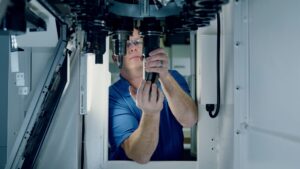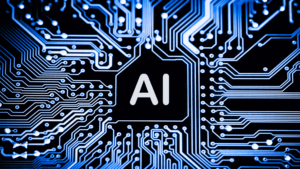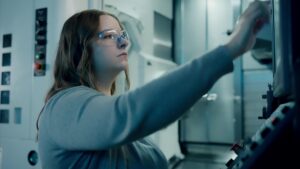
The transition to Industry 5.0 marks a significant evolution in the manufacturing sector, heralding a new era that goes beyond the automation and digitalization of Industry 4.0. This transformative phase, as outlined in the Wikipedia article on the Fourth Industrial Revolution, represents a shift toward integrating human creativity with technological advancements, emphasizing sustainable and collaborative practices over mere efficiency. Morris Group Inc., with its expertise in CNC machinery and advanced manufacturing solutions, is at the forefront of this revolution, aligning perfectly with Industry 5.0’s ethos. This introduction will delve into the importance of Industry 5.0 and Morris Group’s alignment with its principles, setting the stage for manufacturers to understand and adapt to this new industrial era.
Key Aspects of Industry 5.0:
- Human-Centric Approach: Unlike Industry 4.0’s focus on technology, Industry 5.0 emphasizes the value of human input and creativity in manufacturing processes.
- Sustainability: There’s a strong emphasis on eco-friendly practices and reducing environmental impact.
- Collaboration Between Man and Machine: Industry 5.0 fosters a collaborative environment where technology augments human capabilities.
Understanding these aspects is crucial for manufacturers aiming to transition to Industry 5.0. The Forbes article provides deeper insights into how Industry 5.0 is radically changing business strategies, focusing on its societal and human-centric approach.
In the next section, “Technological Advancements in Industry 5.0,” we will delve into the specific technologies that are driving this industrial shift and how manufacturers can leverage them.
Technological Advancements in Industry 5.0

The progression to Industry 5.0 is significantly driven by advanced technologies, reshaping the landscape of modern manufacturing. This era leverages innovations such as Artificial Intelligence (AI), the Internet of Things (IoT), and big data analytics to foster a smarter, more efficient, and human-centered manufacturing environment.
- Artificial Intelligence (AI): AI plays a crucial role in predictive maintenance, quality control, and enhancing decision-making processes. By integrating AI into manufacturing systems, businesses can achieve greater efficiency and precision.
- Internet of Things (IoT): IoT technology facilitates real-time monitoring and control of manufacturing processes. This connectivity ensures seamless communication between machines and human operators, leading to improved productivity and safety.
- Big Data Analytics: The use of big data allows manufacturers to analyze vast amounts of information for insights, leading to optimized production processes and reduced waste.
The implementation of these technologies in manufacturing aligns with the principles of Industry 5.0, which advocates for a balanced approach between technological advancement and human-centric practices. To fully harness the benefits of these technologies, manufacturers need to understand their applications and potential impact on their operations.
As we delve deeper into how these technological advancements shape Industry 5.0, the next section, “Workforce Training for Industry 5.0,” will explore the essential aspect of equipping the workforce with the necessary skills and knowledge to thrive in this new era.
Workforce Training for Industry 5.0

In the era of Industry 5.0, workforce training emerges as a critical element. It’s essential for employees to not only have a firm grasp of their core skills but also to be adept in the latest technological advancements characterizing this new industrial revolution. This evolution in manufacturing necessitates a workforce that is versatile, tech-savvy, and continuously evolving.
- Integrating New Technologies into Skill Sets: The foremost step in this training journey involves familiarizing the workforce with the nuances of AI, IoT, and big data analytics. These technologies are the bedrock of Industry 5.0, and understanding their operation and application in the manufacturing process is crucial.
- Adapting to a Culture of Continuous Learning: Industry 5.0 is marked by rapid technological changes. Therefore, instilling a culture of ongoing learning and adaptability is vital. Employees should be encouraged to continuously update their skill sets to stay abreast of the latest technological trends.
The training strategies must be comprehensive, covering both theoretical knowledge and practical applications. This includes hands-on workshops, simulation-based learning, and collaborative projects that mirror real-world scenarios.
- Developing a Future-Ready Mindset: Training must go beyond technical skills, focusing on fostering a mindset ready for Industry 5.0. This includes nurturing problem-solving abilities, adaptability to change, and innovative thinking.
- Leveraging Collaborative Training Models: Emphasizing collaborative learning where employees can share knowledge and learn from each other is crucial. This can be facilitated through group projects, peer-to-peer learning sessions, and mentorship programs.
- Emphasis on Sustainability and Ethics: Given Industry 5.0’s focus on sustainability, training should also cover eco-friendly practices and ethical considerations in manufacturing.
Training programs must be dynamic, reflecting the evolving nature of Industry 5.0, ensuring that the workforce is not just prepared for today’s challenges but is also adaptable to future advancements.
To conclude, the effective training of the workforce for Industry 5.0 is a strategic imperative. It’s about equipping employees with the skills to leverage new technologies, fostering a culture of continuous learning, and instilling an innovative mindset. As manufacturers navigate this transition, the emphasis should be on preparing a workforce that is not only technologically proficient but also adaptable and forward-thinking. This comprehensive approach to training will be instrumental in driving success in the dynamic landscape of Industry 5.0.
Morris Group’s Role in Industry 5.0
Morris Group Inc. stands as a key player in the transition to Industry 5.0, leveraging their expertise in CNC machinery and advanced manufacturing solutions to meet the era’s demands. Their commitment to integrating human skills with advanced technology aligns perfectly with the ethos of Industry 5.0, focusing on sustainable and human-centric manufacturing practices. Morris Group offers a range of solutions that are crucial for businesses adapting to this new industrial landscape. These solutions, detailed on their Advanced Manufacturing Solutions page, include state-of-the-art machinery that embodies the principles of Industry 5.0 – efficiency, sustainability, and human-machine collaboration.
Morris Group’s role extends beyond providing technology; they are partners in their customers’ journey towards embracing Industry 5.0. They support businesses in understanding and implementing new technologies, ensuring a smooth transition into more sustainable and efficient manufacturing practices.
In the following section, “Preparing for the Transition,” we will discuss the steps and strategies that businesses can adopt to effectively navigate this significant industrial shift.
Preparing for the Transition to Industry 5.0
As businesses prepare for Industry 5.0, a comprehensive approach is essential. The transition involves embracing new technologies, upskilling the workforce, and integrating sustainable practices.
Assessing Current Operations
The first step in preparation is to assess current manufacturing processes. This involves evaluating the existing machinery and technology, understanding its capabilities, and identifying areas for improvement. Businesses can refer to resources like Morris Group’s CNC machinery to understand the advancements in technology relevant to Industry 5.0.
Setting Realistic Goals
Once the assessment is complete, setting realistic and achievable goals is crucial. These goals should align with the principles of Industry 5.0, focusing on sustainability, efficiency, and human-machine collaboration.
In the next part, I will discuss the importance of developing a strategic implementation plan and the role of continuous learning in the transition process.
Developing a Strategic Implementation Plan
After setting goals, the next step is to develop a strategic plan for implementation. This plan should outline the steps to integrate new technologies, such as AI and IoT, into existing processes. It’s important to prioritize areas that will yield the most significant benefits in efficiency and sustainability. Resources like Morris Group’s Automation Within Reach can provide valuable insights into effective technological integration.
Emphasizing Continuous Learning and Adaptation
The transition to Industry 5.0 requires a culture of continuous learning and adaptation. Manufacturers should invest in training programs to upskill their workforce, ensuring they are equipped to handle new technologies and processes. Embracing a mindset of ongoing development will help businesses stay agile and responsive to the rapid changes characteristic of Industry 5.0.
Integrating Sustainable Practices
A key aspect of transitioning to Industry 5.0 is the integration of sustainable manufacturing practices. This involves adopting eco-friendly technologies and processes that minimize environmental impact. Businesses can look to examples set by industry leaders and resources like the TWI Global FAQ on Industry 5.0 for guidance on implementing sustainable practices.
Leveraging Expertise for a Smooth Transition
To successfully navigate this shift, leveraging the expertise of industry leaders like Morris Group is invaluable. Their advanced solutions and insights can significantly aid in aligning businesses with Industry 5.0 standards. Collaborating with experts helps in efficiently adopting new technologies and practices, as showcased in Morris Group’s customer support services.
Embracing the Future with Industry 5.0
In conclusion, preparing for Industry 5.0 involves a multi-faceted strategy. Businesses must assess current operations, set realistic goals, develop a strategic implementation plan, embrace continuous learning, and integrate sustainable practices. Leveraging the expertise of industry leaders like Morris Group can facilitate a smoother transition, ensuring businesses are well-equipped to adopt new technologies and methodologies. This strategic shift is not just about staying current; it’s about positioning for future competitiveness and growth in an ever-evolving industrial landscape. Embracing Industry 5.0 is a journey towards a more efficient, sustainable, and innovative future in manufacturing.
Sources:
- “Fourth Industrial Revolution,” Wikipedia. Link
- “What Is Industry 5.0 And How It Will Radically Change Your Business Strategy?,” Forbes. Link
- “What’s the Difference Between Industry 4.0 and Industry 5.0?,” ISA Blog. Link
- “What is Industry 5.0? (Top 5 Things You Need to Know),” TWI Global FAQ. Link
- “Industry 5.0: Adding the human edge to industry 4.0,” SAP Article. Link
- Morris Group Inc. – Advanced Manufacturing Solutions. Link
- Morris Group Inc. – CNC Machinery. Link
- Morris Group Inc. – Automation. Link
- Morris Group Inc. – Customer Support Services. Link

